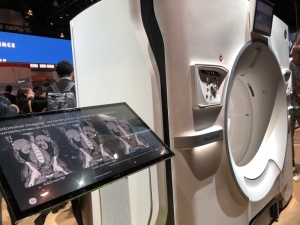GE debuts new applications and devices built on Edison AI platform
by
Lisa Chamoff, Contributing Reporter | November 27, 2018

GE Revolution Apex CT
At RSNA, GE Healthcare unveiled a new portfolio of devices and applications that utilize AI, all built on a new platform called Edison, designed to harness machine learning to improve efficiency and patient care.
“Our theme around the booth is ‘Elevating radiology,’ ” Mark Phillips, chief marketing and commercial officer for GE Healthcare Imaging, told HCB News. “That’s really about helping our customers – individual radiologists, radiology chairs, admins – to really prepare for the future and elevate the practice. There’s a lot of pressure in terms of volume, in terms of reimbursement. We also have done some studies that show there’s some level of fear about the future, so how do we help prepare them for the future as a partner?”
Part of the portfolio of more than 50 applications includes a technology called Deep Learning Image Reconstruction that’s available on GE’s new Revolution Apex CT scanner.
Deep Learning Image Reconstruction uses algorithms based on images that were previously reconstructed, resulting in a much clearer image with less dose.
Jamie McCoy, chief marketing officer for MICT at GE Healthcare, said the technology preserves the texture of the image that radiologists seek, while keeping the dose low.
“There has been pretty remarkable feedback from our customers on what a dramatic difference the image quality is,” McCoy told HCB News.
Edison was also used to develop the Critical Care Suite, a 510(k)-pending application that will be available on the Optima XR240amx mobile X-ray system, which helps identify pneumothorax at the point of care and gives an onscreen alert to the technologist the moment they take the X-ray.
“Customers tell us that on average, even in the U.S., there is probably a four- to eight-hour lag before the X-ray is read,” Chiranjiv Singh, chief marketing officer for X-Ray at GE Healthcare, told HCB News. Pneumothorax was “the No. 1 thing we heard from our U.S. customers as something they wish they could detect because if it’s not treated immediately it can be fatal.”
The technology also includes Automated Lesion Segmentation on LOGIQ E10 ultrasound, which segments breast, thyroid and liver lesions and automatically provides a trace of the lesion and corresponding area.
AIRx, another 510(k)-pending AI technology is a workflow tool for MRI brain scanning designed to make scans more consistent. The Liver Assist V.I. solution identifies the blood vessels feeding a tumor based on an algorithm and helps plan the intervention, reducing procedure time by 11 percent and increasing total tumor response from 34 to 68 percent.
“A lot of the hype in the market is that doctors are going to get replaced,” Phillips said. “There’s so much low-hanging fruit that we can do with AI ... A lot of the solutions that we’re doing [involve] either automating the workflow or helping support a clinical decision.”
The main goal with Edison is to have AI applications on the devices themselves, instead of forcing radiologists into the cloud.
At the same time the company is using Edison to create its own applications and smart devices, GE is looking to clinical partners to use Edison to develop their own algorithms, while allowing technology partners to use the platform to develop additional solutions and products.
“We think there is so much talent out there, we invite them to develop on our platform,” Phillips said.
|
|
|
You Must Be Logged In To Post A Comment
|
